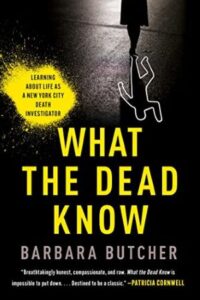I write about very bad things. Gruesome, terrible things. Horrific murders, creepy serial killers, tragic suicides, and painful, senseless accidents. The stories I tell are real, and my experiences as a death investigator at New York City’s Office of the Chief Medical Examiner have proved to me the existence of evil in the world.
Why on earth would I want to write about that, you may wonder?
Because it has been my life for more than twenty years, and I need to come to terms with it. Death, despair, and destruction made me who I am, which is not necessarily good. Now that I’ve retired my latex gloves, I feel that I need to find order, to make sense of it all. There doesn’t have to be a happy ending, but there does have to be meaning. I found mine through writing.
People enjoy true crime, but it has to be true, filled with fact and not fiction. Or worse, half-truths peppered with maybe’s and what if’s? It’s okay to say, “you don’t know.” In fact, that’s a form of narrative strength, one that will engender trust in your reader.
So that’s the first and most important rule of writing True Crime: It has to be true.
Because of my work, my head is filled with stories of the deaths and lives of New Yorkers. These tales are interesting and complicated. Some of them are very hard to believe. It’s always been a writer’s job to convey the incredible in a credible way, and this is especially true when writing about crime. Specifically, death scenes.
Death is rarely neat and it’s never pretty, but there’s a difference between accurately portraying a scene and presenting a deliberately gruesome and sensational picture of death, just because you can.
The biggest offenders here? Adjectives. Too many adjectives clutter the scene and may give the impression that, because you’re trying so hard to capture every little detail, you’re missing out on nuance.You can rely on other ways to get the picture across.
Rule number two: Cut down on the adjectives and lurid language.
A good figure of speech can go a long way when writing about true crime. Similes, metaphors and sometimes personification can really help bring a death scene to life (sorry, bad pun) while providing your reader with familiar ground on which to stand.
While I do want to tell the stories of the cases I’ve worked, I don’t want to disgust or frighten people unnecessarily. So, how to describe the work of a serial killer, his signature move, the state of his victims? One way I have done so is to mention everyday objects or the colors of the scene: “his head was unhinged … a dark red pool of blood spilled from his neck and seeped into the sapphire blue carpet, forming a weird paisley pattern.” There’s something slow and inviting about that sentence, which lets the reader follow the trail of blood as it leaked into the carpet. And ending the sentence with “weird paisley pattern” felt truthful to me, as it conveyed the way in which, even in a bloody crime scene, a small moment of beauty can be found.
That’s my third rule: Build a bridge to your reader with familiar images and objects.
When it comes to describing a scene, we tend to think visually. It’s only natural that a writer would start by telling the reader what everything looks like. Do that and you’re missing all the other senses, namely touch, hearing, smell, and taste. (Yes, even taste can come into it—unfortunately.) I invite the reader into the room by mentioning the sounds and smells around me.
As Truman Capote, the father of True Crime said, “That’s all a writer has to write about—what he sees and hears and what not.”
The odor of a decomposing body is nauseating and difficult to put into words, so I found a good comparison: “strangely sweet with a bitter undertone, like a strawberry milkshake made with garlic.” The mutterings of a police officer, unhappy with his donut choice: “Why do they even bother to put these in the box? Fuck Entenmanns” can take me right back to the tenement hallway where we waited to enter a murder scene. Hopefully it transports the reader, too.
That brings us to rule number four: Rely on all five senses.
So far I’ve talked about how to invite the reader into a crime scene. But it wouldn’t be true crime if the writer holds back on her feelings. Horror, devastation, despair, shock … these are all things felt by first responders (or in my case, a last responder). Sure, we do our best to tamp down the awfulness in what I like to consider compassionate disengagement, but we’re all human, so we have to find ways to deal. That’s where humor comes in. Specifically, gallows humor. This grim and often ironic response is how responders deal with death and mayhem. It certainly is how I made it through my career.
I try to write about the funny things that happen in death without being disrespectful. I always approach my subjects with compassion, but I also feel honor bound to give the reader knowledge of my state of mind—dark and numb. I needed to laugh, to see the humor in a silly accident, otherwise I would cry all the time. Thus, I wrote about a detective’s description of a hoarder crushed beneath his pile of junk, killed by his own booby trap, as a game of “Where’s Waldo?” I thought that was a pretty good joke as we dug through the mess to find him.
And when a foolish young man playing cowboy killed himself when the gun he was twirling flew off his finger, hit the ground and fired a round that hit him right between his eyes, I couldn’t resist. “His first shot was his best shot was his last shot.” You get a real release by telling it like it is.
Which is why rule number five is: Don’t forget the humor.
That brings me to rule number six, which in many ways circles back to my first rule. It takes an odd combination of knowledge, skill, and personality to do my job. That goes double for writing about it. My style is idiosyncratic. Gritty, sometimes. Humorous the next. I don’t shy away from the hard truths, whether they be about my cases or myself. While working my way through my book, I had to dismantle a lot of ideas of what makes an author I also had to dismantle a lot of ideas about myself. That’s rule number six and it’s equally important as rule number one.
Rule Number 5: You can’t write true crime without acknowledging the truth about yourself.
Writing my book enabled me to find the meaning of my life through the deaths I investigated. The act of writing is an act of revelation. And if you aren’t willing to reveal who you are, then you need to switch genres. Romance, perhaps? (I tried it, but it was a little dark for me.)

 Barbara Butcher (yes, that’s her real name) is the former Chief of Staff at New York City’s Office of Chief Medical Examiner (OCME), where she spent over twenty-three years. An expert in medico-legal death investigation and disaster/mass fatality management, she investigated the 1993 bombing of the World Trade Center, helped manage the response to the crash of American Airlines Flight 587 in Queens, New York, and was actively involved with 9/11 victim recovery.
Barbara Butcher (yes, that’s her real name) is the former Chief of Staff at New York City’s Office of Chief Medical Examiner (OCME), where she spent over twenty-three years. An expert in medico-legal death investigation and disaster/mass fatality management, she investigated the 1993 bombing of the World Trade Center, helped manage the response to the crash of American Airlines Flight 587 in Queens, New York, and was actively involved with 9/11 victim recovery.
Barbara currently consults in forensics and death investigation for pathologists, attorneys, television producers, and mystery writers.
She is the author of What the Dead Know: Learning About Life as a New York City Death Investigator.





